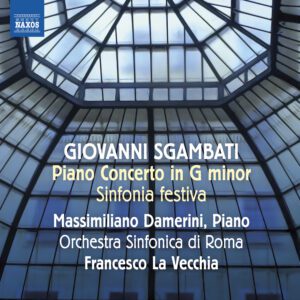Giovanni Sgambati (1841-1914) enjoyed a multi-faceted career. A pupil of Liszt, Sgambati stood out among 19th-century Italian pianists for his advocacy of the German school and classical models. This applied as well to his activities as a composer, conductor, teacher, critic, and esthetician. Indeed, his massive three-movement Piano Concerto in G minor from 1880 might be described as a hybrid that fuses the similarly scaled Brahms D minor concerto with piano writing marked by Lisztian bravura.
Imagine Liszt reworking the echt-Hungarian finale of Brahms’ Violin Concerto for piano on his own stylistic terms, and you’ll get an idea of what Sgambati’s third movement sounds like. Similarly, the grandiose first movement owes much of its existence to the arpeggiated flourishes in Beethoven’s Emperor concerto first movement and motives from Liszt’s Hungarian Fantasy. There’s a lot of padding within the solo part’s idiomatic keyboard layout, which leads me to suspect that Sgambati focused more on the piano than the orchestra in the process of composing his concerto. By contrast, Sgambati’s First symphony dating from around the same time is a masterpiece of structural concision and melodic development.
The present recording stems from live performances that took place at Rome’s Auditorium Conciliazione in 2013, featuring the late Massimiliano Damerini, who handles the daunting piano part brilliantly and confidently. Although I’ve often found this pianist’s studio recordings to be musically stiff and sonically drab, he positively opens up and thrives in front of an audience. What is more, the recorded balance is far superior to the Francesco Caramiello/ Fabrizio Ventura/Nuremberg Philharmonic edition that appeared on both ASV and Tactus, where the overly close-up piano relegates the orchestra to the bleachers.
Those who’ve heard Francesco La Vecchia’s Naxos recording of the aforementioned symphony won’t be surprised by his strong podium leadership and the Rome Symphony’s deft woodwind section. Both conductor and orchestra make a splendid case for Sgambati’s delightful, neo-Dvorákian Sinfonia festiva (‘Ouverture de fête’), presented in its world premiere recording here. However, neither Damerini nor Caramiello matches the resplendent elegance of Jorge Bolet’s gorgeous pianism throughout the first and still best recorded version of the Sgambati concerto, which is out of print, yet not difficult to source.
































